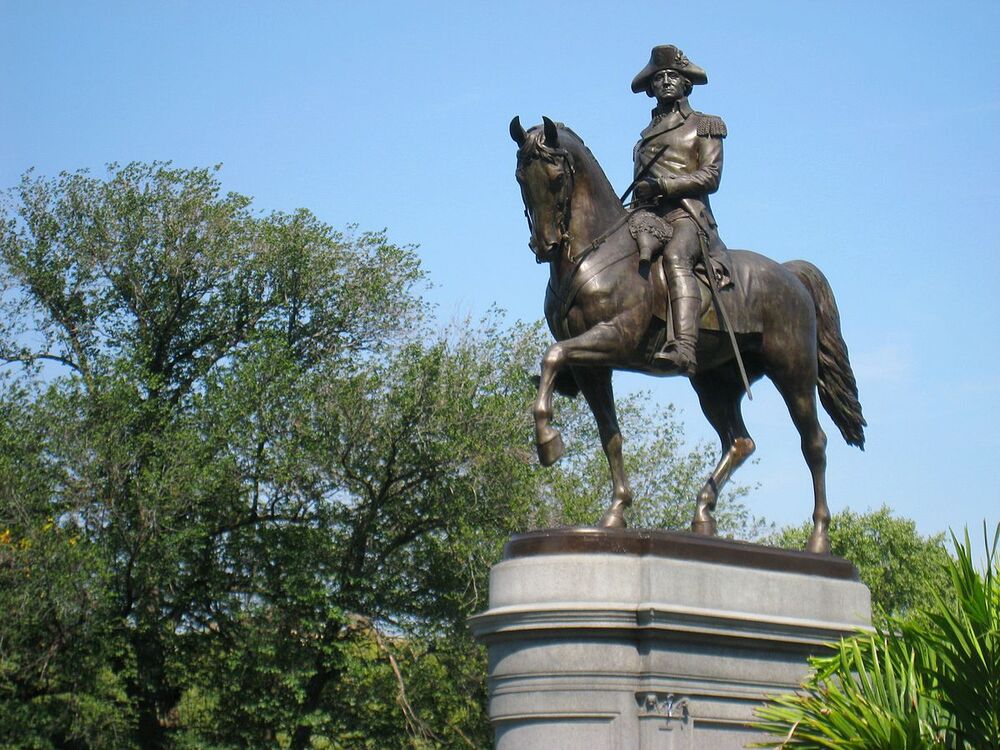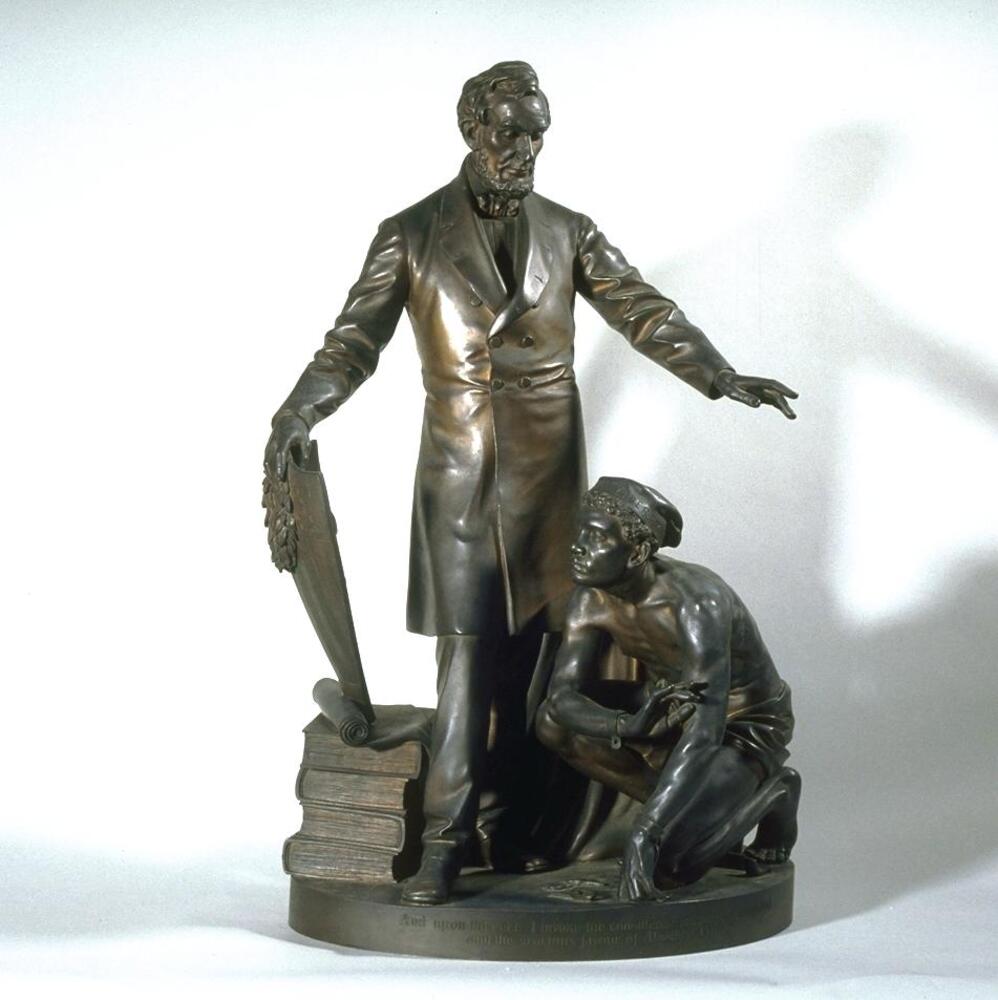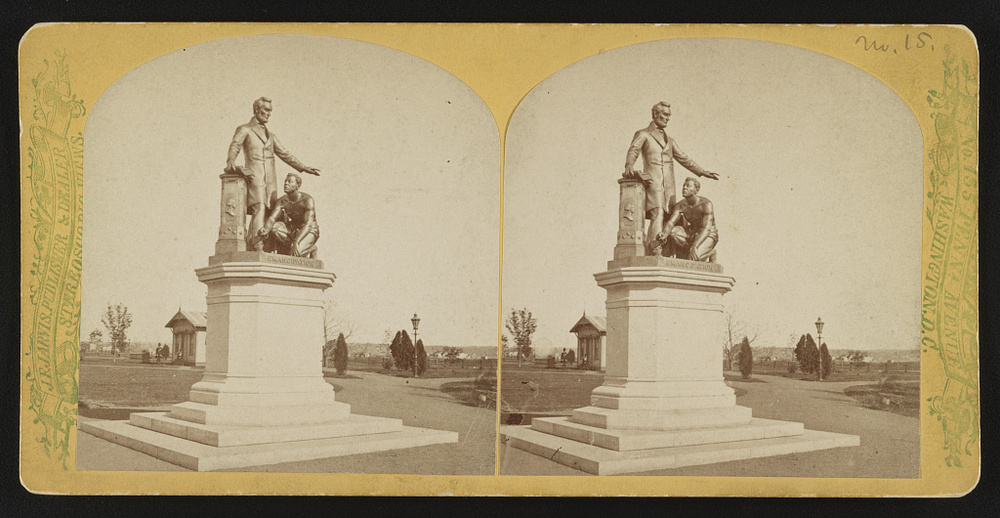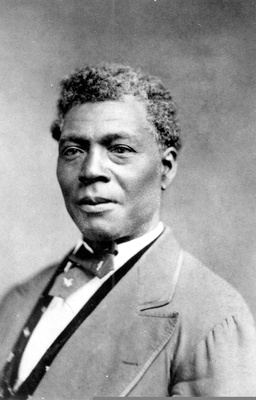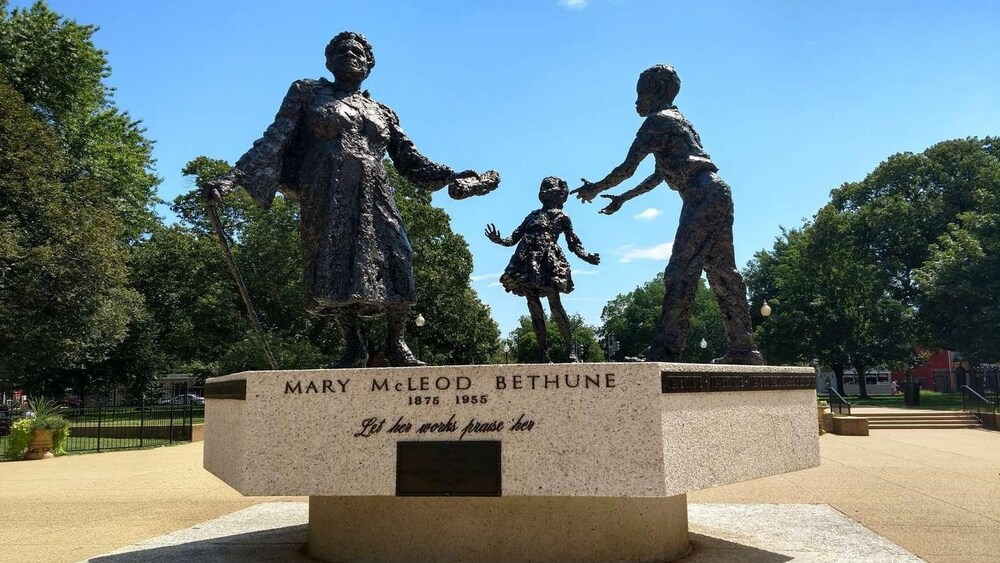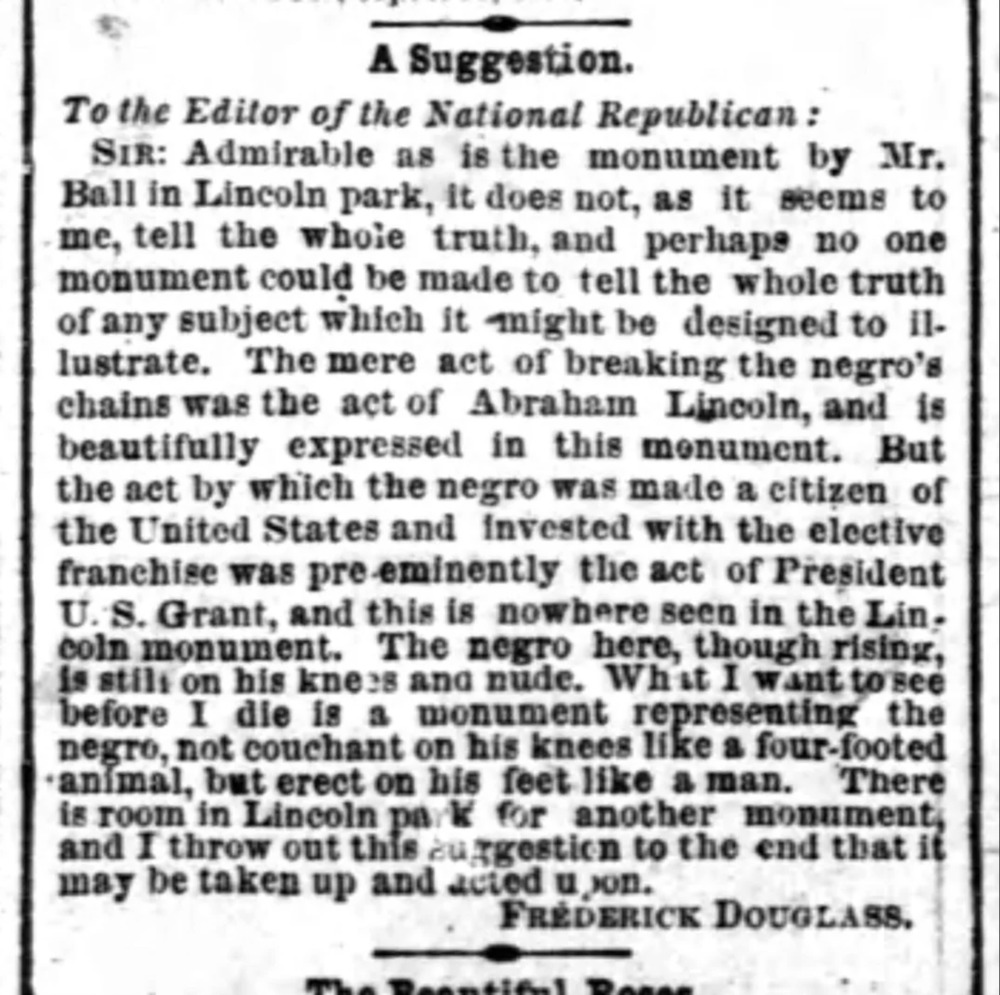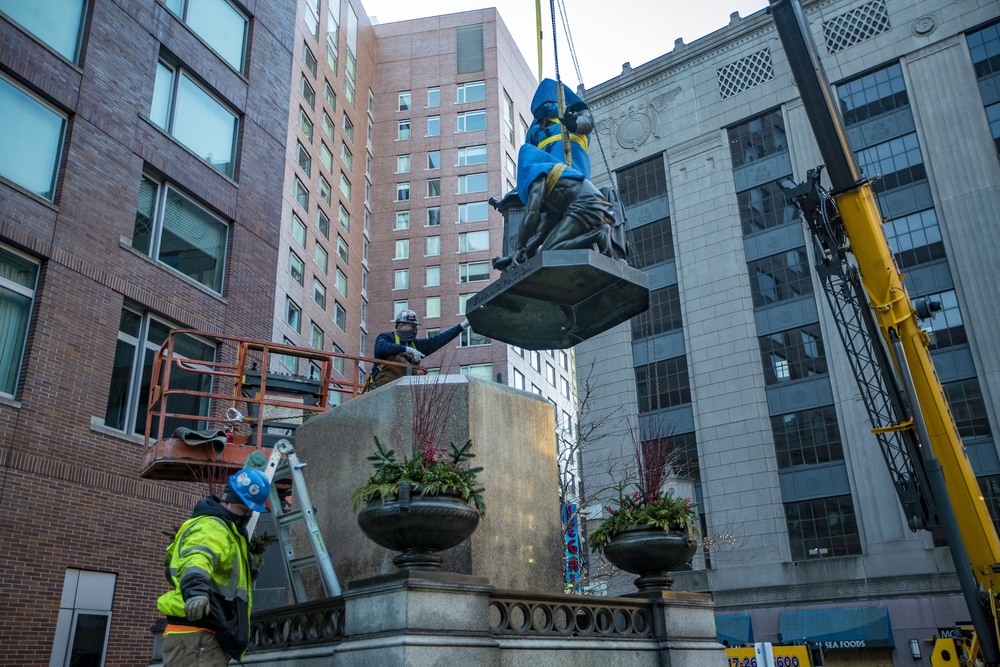The Identity of a Newly Reunited Nation Immortalized through Sculpture
The History and Implications of Emancipation Group By Thomas Ball
This exchange post was created by students in HISTART /AMCULT 230 as a part of a group research project. The project goal was to further examine a piece in the UMMA's collection made in the 1800s.
_______________________________________________________________________________________
Thomas Ball’s Emancipation Group at first glance is an impactful portrayal of emancipation in the United States. After a closer look at this representation however, a struggle for a unified American identity is revealed.
The United States, fresh out of the Civil War, strove to present a unified, powerful image. This is achieved in the sculpture’s portrayal of Lincoln, however the emancipated people are denied the same respectful identity. The emancipated population hoped the monument would portray them as equals and show the part they played in gaining their freedom, with respect for their painful past. Finally, Thomas Ball himself also struggled to find his identity as an expatriate making political monuments for a country he left. Emancipation Group reflects the struggle the United States had with incorporating the emancipated people into their idealized American identity, and the response to the sculpture demonstrates how viewers felt the monument misrepresented the unified and equal identity they had hoped it would portray.
About the Artist Thomas Ball
Thomas Ball moved to Florence, Italy to work and study with fellow artists in 1854. With a rich history as a center for renaissance art in earlier centuries, the allure of Florence remained throughout the 1800’s as expatriates ventured there to expand their career and surround themselves with other art. He first stayed in Italy from 1854 to 1857, establishing himself and his career. During this time, Ball developed a close social circle with other famous sculptors, poets and musicians. As Ball developed his sculpting skills, he worked closely with Hiram Powers, a renowned marble sculptor. While Powers’ focused on the neoclassical style and Ball was more of a realist, Ball was able to refine his marble skills working alongside Powers. This constant exposure to various forms of art and the expertise of his peers certainly impacted Ball, as he moved on to focus on his classic bronze sculptures, finding a middle ground between the cheaper, plaster sculptors and extravagant marble pieces with which he was familiar. Ball had a flourishing career in Florence with a steady stream of commissioned projects expanding his portfolio, and by the time he returned to the United States he had made a name for himself.
Upon returning to Boston in 1857, Ball began to work on his equestrian statue of George Washington. This piece would eventually become his most well known and successful work, showcasing his typical bronze and heroic monuments. Following the successful Equestrian Statue of George Washington, Ball returned to Italy in 1865 and 1870 to build his own home and studio. His estate would later become an academy for young artists, sculptures in particular. He continued to flourish in Italy, developing more heroic monuments of historical figures like Josiah Quincy, Charles Sumner, and John A. Andrew.
Ball received an honorary Master of Fine Arts degree from Dartmouth College. The degree was granted to him in recognition of portraits he had created of various alumni of the institution, one of his more notable of the pieces being his bronze monument to Daniel Webster, on display in Central Park. This award was a great honor that continued to push Ball’s self-made career even further.
Eventually, Ball designed and sculpted Emancipation Group in 1876. By then, his work was well known and this piece highly anticipated. Rather than his typical choice of bronze, Emancipation Group was created with Italian Marble. This material was not completely foreign to him, as some of his previous pieces, such as La Petite Pensée (1871), were also made of marble, and he spent much of his time in Italy with Hiram Powers working with marble. The influence his time in Florence had on Ball is seen clearly in Emancipation Group. The marble material as well as the heroic disposition of Abraham Lincoln clearly demonstrate the influence his fellow expatriates had on his own personal style, and these aspects may be observed in UMMA when viewing the smaller version of the monument. Powers had an undeniable influence on Ball, as there are clear similarities in the positioning of their subjects– particularly in their use of angles. Few of Ball’s subjects are standing perfectly straight– Lincoln, Webster and other subjects of his sculptures are leaning to one side.
Ball would go on to receive both praise from his peers as well as criticism. Emancipation Group, an infamously controversial piece, received some praise as well. In his book “Emancipation and American Sculpture”, Henry Morris Murray recalls praise Ball received from a Mr. Taft: “His [Balls] conception of Lincoln is a lofty one… One of the inspired works of American sculpture; a great theme expressed with emotion by an artist of intelligence and sympathy, who felt what he was doing,” (Murray 1916, 27). However, as Americans visited the Florence studios of various expatriates, some criticized Ball. General William T. Sherman disapproved of his time spent in Italy. In a letter to Ball, Sherman expresses his disdain for the artists that expatriated to Florence, writing: "I need hardly assure you that our wandering vagabond Americans feel an honest pride in the hard-earned success of our artists who must seek in foreign lands the material for their art. But I know that no country cherishes a purer love for the creations of the chisel and pencil than our own…"(Couper n.d, 1). Despite any discouragement, Ball frequently returned to Florence for the rest of his life, eventually being laid to rest in the Protestant Cemetery in Florence, alongside his late wife, Ellen Louisa Wild Ball.
Different Iterations Along the Way
The idea for the piece came to Ball when he heard the news of Lincoln’s unfortunate assassination. At the time, Ball was traveling to Munich, yet like many other artists of the time period, he became quickly engrossed in presenting one of Lincoln’s most well known impacts. The sculpture underwent many changes throughout its development. The bronze maquettes made in 1865, of which there are at least a few copies (like the iterations housed at UMMA, Colby College, and Harvard) are among the earliest designs for the group. The marble model spotted by Elliot, was created around the same time as the bronze maquettes, but then came a marble version in 1873 (now housed at the Chazen Museum of Art) that is more like the final composition of the completed Washington statue and its Boston replica.
_______________________________________________________________________________________
Visual Analysis of the 1865 Maquette
The 1865 maquette housed by the UMMA, is one of the earliest iterations of the Emancipation Group. Standing at 32 15/16” x 21 15/16” x 16 ⅝”, this version of Emancipation Group features a standing Lincoln, one hand holding a laurel wreath and wrestling on a shield, stack of books, and scrolls. The other hand is held out over a kneeling Black man, who appears to be freed from the chains which remain hanging broken around his wrists. In this version the formerly enslaved man wears a cap with the word ‘liberty’ written across the band in all capital letters.
Ball’s composition and artistic decisions present a strong introduction to a recovering nation, portraying its subject in a naturalistic and modern form, rather than fully modeling classical art. One first choice of Ball’s that is reflective of these goals is in the use of modern dress of the time period. Throughout much of the nineteenth century it was common for artists to portray figures conforming to the ancient Greek or Roman standards: nude or nearly nude. Ball, rather than draw from neoclassicism, chose to go the more naturalist route, portraying Lincoln as he would’ve been at the time of the proclamation, clothes and all. This choice of modern dress would’ve made viewers feel less removed from Lincoln, as if they weren’t that far in time or place from the legendary political leader. This removal of neoclassicism in art is reflective of the desire throughout America to move into a new era, rather than to dwell on the past and the events of the civil war.
Ball also used his sculpture to represent the values of the newly reunited nation. He emphasized America’s ideals of strength, unity, and peace, through the imagery of Lincoln. Firstly, Lincoln is portrayed in a stance full of fortitude. His feet are both flat on the ground as if he is standing still, not ready to go anywhere or be pushed over easily. Yet, Lincoln’s shoulders are lowered, and his arms outstretched casually rather than in a movement of defense or aggression. This allows for a relaxed, but dignified air to surround Lincoln, as if he is fully at peace with his monumental decision. Ball also presents Lincoln as wielding a shield with the emblems of the American Union on its front side. This symbol of stars and stripes works to reinforce the concept of Lincoln as the defender of America, fighting for its people and ideas of constitutional freedom and liberty. Lastly his position in relationship to the slave, one taking the top section, while the other spreading over the bottom half, allows for a great sense of balance and unity in the sculpture. Everyone is where they need to be for the composition to be united and whole, just like the Union newly reunited, with Confederate states put back in their places.
This is where the sculpture begins to contradict itself. While it succeeds in presenting the ideas and values of Lincoln and a reunited America in its portrayal of the former president, it fails to break free from harmful depictions of Black individuals.
As stated in the paragraph above, the positioning of Lincoln towering above the slave in the sculpture seems natural in this composition. It’s almost as if that is the only place the slave figure would fit into this piece, but this placement imbues the sculpture with a mentality of the Black individual being unequal to Lincoln. Ball also places books and documents on the far left of the sculpture, on the side of Lincoln. The only way for the slave to get access to these symbols of learning and intellect, would be to cross Lincoln and leap up to reach them. However, unlike Lincoln, the former slave is not in a powerful and commanding stance. He is crouching, in between sitting and standing, placing him in an unstable state of transition. This means the former slave is not granted the same level of dignity and agency as Lincoln is in the sculpture, he can’t simply leap up and take a book. By placing these symbols out of reach of the slave it emphasizes an idea many white Americans held: that Black people are less capable of learning and that the only person that can gift knowledge to them is a white man, in this case Lincoln specifically. The continuation of white savior narratives in art shouldn’t be surprising, but it is still disappointing coming from this time of national change.
While this Emancipation Group maquette created in 1865, begins to integrate the new history of America into the world of art, it makes it clear that one thing will remain present in post-emancipation society: American ideas of racial superiority.
_______________________________________________________________________________________
Changes in the 1876 Washington Monument
The final monument, roughly 10’ tall and revealed in 1876, presented some changes in details, but kept most of the general composition of the earlier maquettes. The liberty cap on the former slave has been removed. The books and shield have been replaced by a pillar, and the inscription along the base of the statue has been simplified to simply read “Emancipation”
The most interesting change in the final composition is the alteration of the freedman’s face. In the first iterations, Ball simply used himself as a model for the posture and features of the man. For the final iteration however, “Ball relied on photographs of Archer Alexander, the last slave returned to slavery under the Fugitive Slave Act, for the modeling of the Freedman’s Face” (Perecocco 2008, 15). Some believed this change was effective, “In the original the kneeling slave in represented as perfectly passive, receiving the born of freedom from the hand of the great liberator. But the artist has justly changed all this, to bring the presentation nearer to the historical fact, by making the emancipated slave an agent in his own deliverance” (Murray 1916, 30). But as Murray argues in his book, “...whatever alterations were actually made, viewing the group as it now stands, it requires a pretty strong pull on the imagination to find warrant for the claim that the slave is “exerting his own strength with strained muscled.”” (31)
With the final composition also comes the addition of more symbolic details in the background. “Behind Lincoln and the Freedman is a whipping post with blooming roses creeping up and entwining the physical pillar of the institution of slavery. A broken lash and fetter that… symbolize the end of slavery.” (Perecocco 2008, 17) Curiously, these additions are mostly hidden from the viewer’s view, from where the statue sits on its pedestal. “To see them, I have to hoist myself up on the pedestal, wondering, as I strain, what was the point of sculpting them if no one can see them to understand their symbolism”(17). The inclusion of these symbols only to place them where they are for the most part hidden, ultimately might also play into the contradictions of modern values and historical ideas that the statue presents. It is almost as if they are trying to say slavery and discrimination are gone on paper, but by placing the symbols out of sight, the statue actually effectively represents how in the reconstruction period these policies continued to be ignored as Jim Crow laws and voting restrictions were put in place.
_______________________________________________________________________________________
Emancipation Group’s Story of Creation
Thomas Ball’s Emancipation Group has a rather long and contentious history, from its concept and development, to unveiling, and to decades of display as a monument.
The story of this monument begins far away from Ball, with one formerly enslaved woman named Charlotte Scott. Working as a washerwoman at the time of Lincoln’s assassination in 1865, Scott famously planted the seed for erection of a monument in honor of Lincoln and his actions. As she said, “The colored people have lost their best friend on earth. Mr. Lincoln was our best friend and I will give five dollars of my wages toward erecting a monument in his memory.”(Perecocco 2008, 8) Her donation inspired a local movement in her community, which then “caught the attention of Brigadier General T. C. H. Smith, commander of the St. Louis garrison. Smith convinced the Western Sanitary Commission president, James E. Yeatman, that this was a worthy project and that the commission should see it through…” (8) . Yeatman then continued to release notices of the movement for funds, and by December of 1865, a total of over $16,000 had been raised in support of the project. The goal of the fundraisers however, was to have all the donations coming from Black communities and those who were formerly enslaved.
Despite funding the monument however, Black communities had essentially no say in the design of the monument. In the end, these decisions were taken over by the heads of the fundraising campaign: William G. Elliot, college president of the Western Sanitary Commission, and James E. Yeatman. On his travels to Florence in 1869, Elliot visited Ball’s estate, and came across the 1865 model of Emancipation Group, stating in a letter to Yeatman that the artwork is “a small group, half life size, of Lincoln and a slave, which [he likes] very much… It is in marble and very well executed.’’ (Perecocco 2008, 12)
Elliot included a picture of the sculpture in his letter and ultimately, the committee was convinced to move forward in pursuit of Ball’s design. They reached out to Ball asking him to send photographs of the piece and his thoughts on terms to make a full sized version. Ball recall’s this correspondence in his autobiography, “I received a letter from Rev. Mr. Elliot. . . . He had visited my studio and had always pleasantly remembered a small group of Abraham Lincoln and a liberated slave, and that he was one of the committee of the ‘Freedmen’s Memorial Society,’ empowered to select a design for the memorial; requesting me to submit to the committee photographs of the above group, and my terms for furnishing the same in bronze, nine or ten feet high.” (Perecocco 2008, 13) After doing as the committee requested, he accepted their offer of $17,000 (all of which had supposedly been raised by formerly enslaved persons), and enlarged the model to 10 feet before sending it off to be cast in bronze.
19th Century Public Opinion of Emancipation Group
Controversy and criticism over Emancipation Group did not solely arise in recent history. Key historical figures have reflected over the sculpture’s meanings, ever since the creation, and have voiced their opinions. In fact, avid abolitionist Frederick Douglass, the man who gave the unveiling speech of the sculpture, wrote a letter that was published by the National Republic newspaper after his speech, articulating the issues of Ball’s sculpture. He declared, “[a]dmirable as is the monument by Mr. Ball in Lincoln park, it does not, as it seems to me, tell the whole truth, and perhaps no one monument could be made to tell the whole truth of any subject which it might be designed to illustrate” (White 2020). Douglass’s initial unveiling speech, given on April 14, 1876 carried a patriotic and united tone, emphasizing that from that day on, America will have a new sense of unity. The Memorial was something for Americans to look at and be reminded of how far our country has come since its creation. However, Douglass had other thoughts later that year, after his speech. He, among other African Americans in society at the time, was simply uncomfortable with the monument’s portrayed image. The letter that captured his thoughts is attached and highlights more of Douglass’ objections to Ball's sculpture.
In addition, historian Kirk Savage discusses the fact “that opposition to the Emancipation Memorial isn’t a modern phenomenon… Savage quotes a witness to Douglass’s oration at the memorial who wrote that Douglass said the statue ‘showed the Negro on his knees when a more manly attitude would have been indicative of freedom’ ” (Heim 2012). The opposition believed that the monument did not reflect the truth and that the paternalistic aura of the sculpture does not give the African Americans justice they deserved. They aided in their own emancipation and the sculpture disagrees with that fact as it highlights a single man helping out an entire race.
In an additional section of his 1876 letter, Douglass called for an additional statue that better represents the African American story and states that “[t]here is room in Lincoln park for another monument and I throw out this suggestion to the end that it may be taken up and acted upon” (White 2020). In response to this, another statue was erected in Lincoln Park, the Mary McLeod Bethune Statue created by Robert Berks, about 100 years after the Emancipation Group was dedicated. The sculpture visually portrays children engaged in action and a woman whose posture is upright and proud. This exudes a positive image that Ball’s monument lacked. Bethune was known for being “one of the most important black educators, civil and women’s rights leaders and government officials of the twentieth century” (Michals 2015). It is apparent that this statue represents African Americans in a more accurate light as to show the amazing accomplishments done by many African Americans.
Depicting the complex history of slavery in the United States was extremely challenging. Ball’s sculpture was just one of the many attempts to accurately symbolize the ever polarizing existence of slavery.
“Admirable as is the monument by Mr. Ball in Lincoln park, it does not, as it seems to me, tell the whole truth, and perhaps no one monument could be made to tell the whole truth of any subject which it might be designed to illustrate.” (White 2020)
_______________________________________________________________________________________
Similar Sculptures
Thomas Ball’s Emancipation Group was not his only sculpture of the 19th century that encapsulated an important figure in United States history. Along with Abraham Lincoln, Ball crafted sculptures that eternalize great American figures Henry Clay and Daniel Webster. It is key to note that very apparent parallels are seen across the three sculptures. In 1853, Ball created a bronze sculpture of Daniel Webster. Webster is well-dressed and standing with a proud posture; his gaze tilted away center. Beside him is a column covered in drapery along with two books. The bronze statue is placed on a pedestal.
In 1858, a bronze sculpture of Henry Clay was created by Ball. Like Webster, Clay is well-dressed and his posture mirrors that of Webster in Ball’s Webster sculpture. A column with a drape covering it is beside Clay. Again, this sculpture is put on a pedestal. Most recently, in 1865, Ball created the Emancipation Group sculpture, which a copy can be seen in UMMA. This is a bronze sculpture that depicts Abraham Lincoln with a newly freed slave who was said to be “Archer Alexander, the last slave captured under the Fugitive Slave Act” (Rosales 2016). Just like the other two Ball sculptures, Emancipation Group had Lincoln standing tall. A stack of books lay to the side of Lincoln as well. Looking at the type of material (bronze), the way the subjects were positioned (upright), and the objects around the main subjects (books, drapery, columns), these three sculptures embody Ball’s specific style and theme that he stuck with when immortalizing prominent US history figures.
Expanding on Ball’s Emancipation Group, similarities did not only exist in his own work, but other sculptures during the time period. Taking a look at Edmonia Lewis’ 1867 sculpture titled Forever Free, many similarities can be seen when compared to Ball’s Emancipation Group. Edmonia Lewis was a sculptor of African and Native American descent. She worked in Rome, Italy for a good portion of her career and her art is here juxtaposed to another American artist who spent time in Italy, Ball (Moorhead 2021). Two subjects exist in both sculptures, one that is standing upright, the other bending or kneeling down below the other. Both subjects in each sculpture have gazes that lean away from the center. However, both figures in Lewis’ sculpture have hopeful gazes, portraying more of a positive outlook for the future of newly emancipated African Americans. Additionally, the depiction of broken chains is a key factor in both sculptures, representing the new freedom gained yet also maybe some of the lingering negative effects of the drastic societal change caused by the elimination of slavery.
Noticing similarities among pieces of art during a certain time period can explain a lot about how society views an issue.
Modern Significance / Recent History
The Emancipation Group and its several copies recently were called to light for their demeaning design. Similar to the Confederate memorials around our nation, the Emancipation Group has been a subject of controversy for years. Though the original monument in Washington D.C. was funded entirely by former slaves, the design was created without their input. As Hannah Bessette mentioned on NPR, “it is important to note the intentions were white-based intentions as it was a white-created statue” (NPR 2020). The “white-based intentions” were the driving factor of the monument misrepresenting the identity the emancipated people wanted to be portrayed as. Others criticized the patronizing design as Lincoln is standing proudly above the hunched over freed slave. One Boston resident said “This is a frozen picture. This man is kneeling. He will never stand up” (NPR 2020). The design also neglects the role African Americans played in their own liberation. It not only awards Lincoln the credit of emancipation, but it also downplays the severity of slavery. The freed slave’s smooth back is an inaccurate representation of the backs of slaves which were routinely ravaged by scars from whips and abuse.
After these design flaws were brought to the attention of the general public, a petition to remove the monument received more than 12,000 signatures. The copy in Boston was removed by an unanimous vote from members of the Boston Art Commission in June of 2020. The removal of the copy in Boston made people wonder why the same statue should be allowed in Washington D.C. In the same month, a fence was put up around the monument in D.C after a confederate monument was torn down by protesters a few blocks over. Following this, the fence was decorated with thoughts and opinions of the controversial monument. One sign on the fence reads “This is not what a free man looks like” (Dcist 2020). The idea points out the fact that a free man should be fully clothed and eye to eye with Lincoln. As the D.C. monument looked like it would fall to the pressure of the protests, President Trump signed an executive order to protect the monument and others like it. Trump, along with many others, felt the monument needed to stand to preserve our national heritage. Though the original monument still stands in D.C., it may follow in the path of its copy in Boston.
In addition, there is a discussion regarding the forceful removal of the monument. A Harvard student who organized protests surrounding the monument advocated to “get rid of it entirely, by any means necessary” while others feel the monument should be removed legally (Dcist 2020).
Moving forward, there are different ideas for how the monuments in Boston and DC should be taken care of after their removal. The removed Boston copy is temporarily in storage while DC residents imagine what they will do with the monument if it is removed. It could be melted down, changed to a preferable design, or put in a museum. Elliot Williams of the DCist noted how some feel the monument could be melted into a park bench. People against this idea argue that it shouldn’t be destroyed because it is a historical artifact and therefore it deserves to be preserved. A museum would allow people to view the statue with more context so viewers can better understand the history of the monument.
The pressure to remove Ball’s monument is not unique to just this monument. Countless other civil war statues and monuments also are under scrutiny for similar reasons. According to the Southern Poverty Law Center, 157 memorials have been removed since George Floyd’s murder in 2020. One of those being the Boston copy of Thomas Ball’s Emancipation Group. In 2021, 73 confederate monuments were removed or renamed leaving 723 in the United States as of 2022. Though these monuments should be preserved, their designs and messages reflect our nation's painful past, and not the unified country we are working to be.
Ater, Renee. “On the Removal of Statues: Freedmen's Memorial to Abraham Lincoln.” Renée Ater, January 15, 2022. https://www.reneeater.com/on-monuments-blog/2020/7/1/on-the-removal-of-statues-freedmens-memorial-to-abraham-lincoln.
Ball, Thomas. My Threescore Years and Ten: An Autobiography. Nabu Press, 2010.
Brockell, Gillian. “Controversial Lincoln Statue Is Removed in Boston, but Remains in D.C.” The Washington Post. WP Company, December 29, 2020. https://www.washingtonpost.com/history/2020/12/29/lincoln-statue-removed-boston-dc/.
Brown, DeNeen L. “Depicted kneeling before Lincoln, this enslaved man broke his own chains in pursuit
of freedom.” Last modified July 6, 2020. https://www.washingtonpost.com/history/2020/07/06/archer-alexander-emancipation-memorial-slavery-lincoln/
Chazen Museum of Art. n.d. “Emancipation Group” Accessed April 19, 2022. https://chazen.wisc.edu/collection/446/emancipation-group/.
Colby College Museum of Art. n.d. “Emancipation Group” Accessed April 19, 2022. http://browse.americanartcollaborative.org/object/ccma/240.html.
Douglass, Frederick, “Oration by Frederick Douglass, delivered on the occasion of the unveiling of the
Freedman's monument in memory of Abraham Lincoln.” Digital Public Library of America,
http://dp.la/item/8bc54d540ed276aadd08279bf58136d8.
Douglass, Frederick, Alfred Whital Stern, Morris H Briggs, Alfred Whital Stern, Alfred Whital Stern
Collection Of Lincolniana, and Daniel Murray Pamphlet Collection. Oration by Frederick
Douglass, delivered on the occasion of the unveiling of the Freedmen's Monument in memory of Abraham Lincoln, in Lincoln Park, Washington, D.C., April 14th, . With an appendix. Washington, D.C., Gibson Brothers, Printers, 1876. Pdf. https://www.loc.gov/item/12006733/.
This link takes you to Douglass’ Oration given at the opening of the Emancipation Monument. Reading this sparked research into public opinion of the statue during the 19th century. Douglass’ oration had a different tone than the overall public opinion. In this oration, Douglass believed the statue was a depiction of unity and positive change. He said the day the statue went up was remarkable and a major turning point in the country’s future. The overall positive vibe Douglass gained from the statue in his Oration did not last long as more people had time to develop their own opinions on the statue depicting emancipation.
Harvard Library. n.d. Accessed April 19, 2022. https://library.harvard.edu/sites/default/files/static/onlineexhibits/emancipation/lincoln.html
Heim, Joe. “On Emancipation Day in D.C., Two Memorials Tell Very Different Stories.” The Washington Post. WP Company, April 15, 2012. https://www.washingtonpost.com/lifestyle/style/on-emancipation-day-in-dc-two-memorials-tell-very-different-stories/2012/04/15/gIQAj3u9JT_story.html.
Michals, Debra. “Mary McLeod Bethune.” National Women's History Museum, 2015. https://www.womenshistory.org/education-resources/biographies/mary-mcleod-bethune.
In this article, Moorhead discusses the life of Edmonia Lewis and how her work was such a pioneering event in art history. Lewis was the first African American sculptor to work professionally. An orphan and victim of racism, she moved to Boston to study sculpture. She luckily gained the opportunity to travel to Europe where she studied more sculpture in Rome. White marble was the prominent art form in that area so she became a skilled marble sculptor. Her work reflected her African American and Native American heritage and we can see that in the example above, Forever Free. Lewis’ connection to Ball as an American sculptor who studied in Italy drew our attention and allowed for comparisons with their emancipation depictions in their sculptures.
Morris, Murray Freeman Henry, and John Wesley Cromwell. Emancipation and the Freed in American Sculpture: A Study in Interpretation. Freeport, NY: Books for Libraries Press, 1972.
Murray, Freeman H.M. Emancipation and the Freed in American Sculpture: A Study in Interpretation.
Washington DC: Murray Brothers, 1916.
Percoco, James A. Summers with Lincoln Looking for the Man in the Monuments. New York: Fordham
University Press, 2008.
Rheims, Maurice. 1977. 19th century sculpture. New York: H.N. Abrams.
Rhoden, Giselle, and Dalila Paul. “73 Confederate Monuments Were Removed or Renamed Last Year, Report Finds.” CNN. Cable News Network, February 3, 2022. https://www.cnn.com/2022/02/02/us/confederate-monuments-removed-2021-whose-heritage/index.html#:~:text=After%20the%20murder%20of%20George,year%2C%20according%20to%20the%20SPLC.
Rosales, Emily. “American Art Collaborative.” Emancipation Group, Colby College Museum of Art | American Art Collaborative, 2016. http://browse.americanartcollaborative.org/object/ccma/240.html#:~:text=One%20of%20his%20best%2Dknown,honor%20Lincoln%20and%20his%20accomplishments.
Rosenblum, Robert, and H.W. Janson. 1984. 19th Century Art. New York: Abrams.
Sculptor Thomas Ball. Accessed April 12, 2022. https://www.wingedsun.com/books/ball.htm.
“Thomas Ball.” Hirschl & Adler. Accessed April 12, 2022. https://www.hirschlandadler.com/galleries/thomas-ball2.
This article acts as a general biography of Thomas Ball. This resource also provides more information regarding Ball's personal life as well as upbringing, rather than focusing solely on his career, which allows the biography section of this piece to be more of a holistic representation of Ball’s life, rather than information solely about his career as a sculptor. This article was utilized to provide general information about Ball’s personal life in addition to information about his career and time in Florence.
“Thomas Ball.” Smithsonian American Art Museum. Accessed April 12, 2022. https://americanart.si.edu/artist/thomas-ball-218.
“Thomas Ball.” Thomas Ball - Artists - Spellman Gallery. Accessed April 12, 2022. https://www.spellmangallery.com/artists/thomas-ball.
This article goes into great detail regarding Ball's time in Italy as well as the progression of his career. Describing some of the accomplishments and awards Ball was granted in his lifetime, like his honorary Master of Fine Arts Degree from Dartmouth College. This article is immensely helpful in understanding the trajectory of Ball's career, and it is utilized in the biography section of the piece to convey the path Ball took to reach success– from Florence to the states and eventually Florence again.
WBUR, Cristela Guerra. “Boston to Remove a Copy of Thomas Ball's 1876 Emancipation Memorial.” NPR. NPR, July 1, 2020. https://www.npr.org/2020/07/01/885692228/boston-to-remove-a-copy-of-thomas-balls-1876-emancipation-monument.
White, Jonathan W., and Scott Sandage. “What Frederick Douglass Had to Say about Monuments.” Smithsonian.com. Smithsonian Institution, June 30, 2020. https://www.smithsonianmag.com/history/what-frederick-douglass-had-say-about-monuments-180975225/.
Douglass’ eventual disapproval of Emancipation Group provides valuable insight into the public opinion of the statue at the time of its unveiling, specifically among the African American community. This article discusses Douglass’ reaction, especially his point of view that no statue may adequately represent the whole truth of enslavement in America. When discussing public opinion of the piece in the 19th century, this article is utilized to deeply analyze the complicated and controversial history of Emancipation Group, rather than providing a simple answer of whether or not the public approved of the monument.
Williams, Elliot. “The Lincoln Statue in Capitol Hill Has Become a Monument to Public Debate Itself.” DCist, July 3, 2020. https://dcist.com/story/20/07/02/dc-emancipation-memorial-lincoln-public-debate-black-history/.
Picture Credits
after J.A. Scholten. Archer Alexander. ca. 1870. Retrieved from the Digital Public Library of America,
https://mohistory.org/collections/item/N11598. Accessed April 9, 2022.
Ball, Thomas. “Daniel Webster.” U.S. Senate: Daniel Webster, March 17, 2021. https://www.senate.gov/art-artifacts/fine-art/sculpture/24_00006.htm.
Ball, Thomas. “Emancipation Group.” University of Michigan Museum of Art. Accessed April 14, 2022. https://quod.lib.umich.edu/m/musart/x-1895.13/*.
Ball, Thomas. “Henry Clay.” U.S. Senate: Henry Clay, March 17, 2021. https://www.senate.gov/art-artifacts/fine-art/sculpture/24_00007.htm.
Brockell, Gillian. “Controversial Lincoln Statue Is Removed in Boston, but Remains in D.C.” The Washington Post. WP Company, December 29, 2020. https://www.washingtonpost.com/history/2020/12/29/lincoln-statue-removed-boston-dc/.
“Category:Equestrian Statue of George Washington (Boston Public Garden).” Wikimedia Commons. Accessed April 19, 2022. https://commons.wikimedia.org/wiki/Category:Equestrian_statue_of_George_Washington_(Boston_Public_Garden).
Jarvis, J. F. , Publisher. Emancipation Monument, Lincoln Park, Washington, D.C. - Thomas Ball,
sculptor. Washington D.C. Lincoln Park, None. [Washington, d.c.: j. f. jarvis, publisher & dealer,
135 penna. avenue, between 1876 and 1910] Photograph. https://www.loc.gov/item/2005696210/.
National Park Service. n.d. “Mary McLeod Bethune Memorial.” Accessed April 19, 2022. https://www.nps.gov/places/000/mary-mcleod-bethune-memorial.htm.
Shea, Andrea. 2020. “Controversial Emancipation Statue Is Removed From Its Pedestal In Boston.” Accessed April 19, 2022. https://www.wbur.org/news/2020/12/29/lincoln-emancipation-statue-boston-removed.
The Met. n.d. “Forever Free.” Accessed April 19, 2022. https://www.metmuseum.org/art/collection/search/846939.
Wikimedia Commons. “File:George Washington statue by Thomas Ball, Boston.JPG.” Accessed April 19, 2022. https://commons.wikimedia.org/wiki/File:George_Washington_statue_by_Thomas_Ball,_Boston.JPG.
Created For
K-12 EducatorK-12 Student
Museum Visitor
UMMA Docent
UMMA Staff
University Faculty
University Student
Rate this Resource
AVG: 0 | Ratings: 0
& Author Notes
Creative Commons by-nc-saLast Updated
April 20, 2022 8:13 p.m.Report
Reporting Policy
